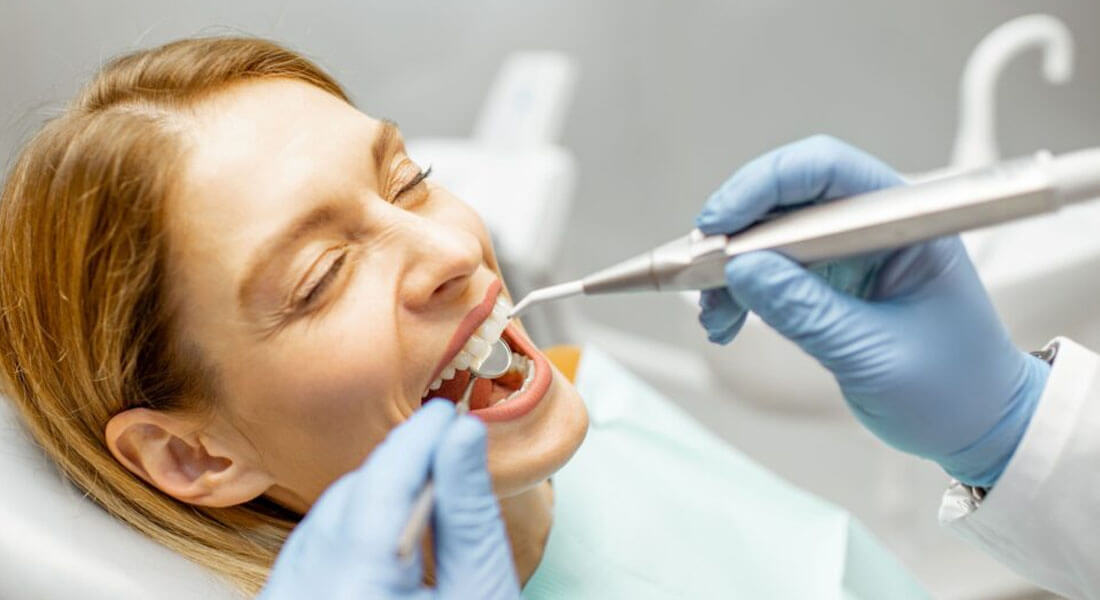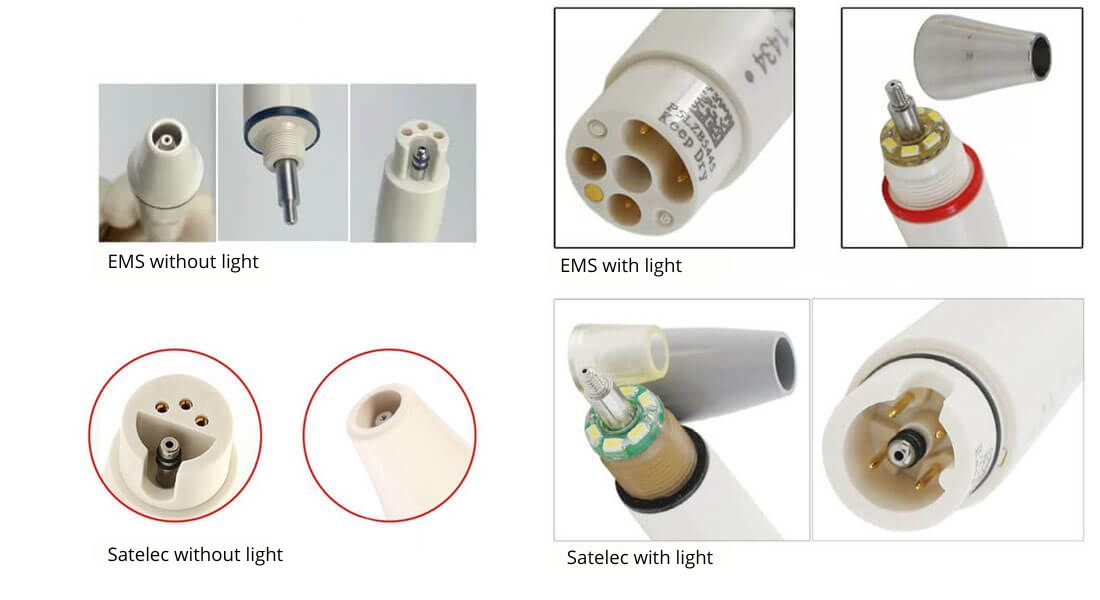Technology has radically transformed the way professionals approach treatments. What a few decades ago was done only with manual instruments and long scaling sessions is now done more quickly, accurately, and comfortably thanks to ultrasonic equipment. Among these, the ultrasonic handpiece plays a leading role: the dentist holds and manipulates it during the procedure, and it transmits ultrasonic vibrations that enable the effective removal of calculus, bacterial plaque or biofilm.
Not all handpieces are the same; there are different models depending on their type of connection, the possibility of having integrated LED light, or their sterilisation and maintenance characteristics. In addition, thanks to the variety of inserts available, their applications can be extended beyond prophylaxis: they are used in periodontics, endodontics, implantology, oral surgery, etc.
For all these reasons, choosing the right handpiece and knowing how to use it correctly is essential to ensure safe, efficient and comfortable treatments for both the patient and the dentist. We'll tell you how to do it!

What ultrasonic handpieces are used for and how they are used
Before discussing specific uses, let's define what an ultrasonic handpiece is. It is the instrument that transmits the ultrasonic energy generated by a device to the tooth through specialised inserts or tips. These vibrations, combined with water irrigation, allow for the removal of calculus, bacterial plaque and stains much more efficiently than with traditional manual instruments.
The handpiece also has a water irrigation system, which performs two essential functions: cooling both the handpiece and the treated surface, preventing overheating; and enhancing the cavitation effect, i.e. the formation of microbubbles that help to disrupt the biofilm and improve subgingival cleaning.
Different uses of ultrasonic handpieces
Their clinical versatility means they are used in different dental specialities:
- Dental prophylaxis and periodontal maintenance: removal of supragingival and subgingival calculus, extrinsic stains and biofilm.
- Advanced periodontics: decontamination of periodontal pockets and root planing with specific smaller gauge tips.
- Endodontics: activation of irrigants, localisation of calcified canals, removal of posts or instrument fragments.
- Restoration: removal of old filling materials, cements and composites.
- Implantology: decontamination of implant surfaces using tips designed not to damage titanium.
- Oral and piezoelectric surgery: in more specialised equipment, these allow precise and minimally invasive osteotomies to be performed.
Thanks to this wide range of applications, ultrasonic handpieces are a safe investment for any dental clinic, as they are used constantly in high-demand treatments.
Procedure for using ultrasonic handpieces
The correct use of an ultrasonic handpiece ensures clinical effectiveness and patient safety. The general procedure includes several phases:
- Connecting the handpiece to the generator: it is essential to check the compatibility between the two, as there are different connection systems (EMS, Satelec, NSK, KaVo, etc.).
- Fitting the tip or insert: the tip is screwed onto the end of the handpiece using a torque wrench. This tool ensures that the tip is tightened to the correct torque, preventing it from loosening during use and avoiding excessive pressure that could damage the part or reduce the tip's service life.
- Checking the irrigation: before starting, check that the water flow is adequate. Water not only prevents overheating, but also aids cleaning and the removal of debris.
- Selecting power settings: the power is adjusted according to the type of treatment and the insert. Medium-high power may be required for supragingival calculus removal, while low power is recommended for subgingival periodontics to avoid damaging the roots or soft tissues.
- Working technique: the handpiece should be held with a firm but comfortable grip and the tip should be placed gently on the tooth surface, always in constant and controlled motion. Excessive pressure should never be applied, as it is the ultrasonic vibration (and not manual force) that removes the calculus.
By following these steps, the handpiece becomes an effective, safe and comfortable instrument, offering significant advantages over traditional manual instruments.
Ultrasonic handpiece connections
One of the most important aspects when choosing an ultrasonic handpiece is the type of connection. This determines whether the handpiece is compatible with the generator you already have in your clinic and with the variety of inserts or tips you want to use. Unlike other dental instruments, ultrasonic handpieces do not have a single universal connection; each manufacturer develops its own systems or systems that are compatible with certain standards. Therefore, knowing the connections well will allow you to avoid purchasing mistakes and get the most out of your ultrasonic equipment.
EMS connection
This is the most widely used connection worldwide and, in many ways, has become a benchmark standard in dentistry. Its great advantage is its versatility: it allows you to work with a wide range of inserts, both from the brand itself and from other compatible manufacturers, which greatly facilitates access to spare parts and accessories. This makes it a very practical option for clinics looking for a flexible system that can be adapted to different professionals and treatments. In addition, handpieces with EMS connection are usually available in both basic versions and with integrated LED light, allowing you to choose according to your clinical needs.
Satelec connection
Widely used in Europe, especially in clinics with a more periodontal or surgical profile. This system is characterised by offering a wide variety of tips designed for advanced treatments, from subgingival periodontics to oral surgery. Handpieces of this type also stand out for their ergonomics, which facilitates comfortable handling during prolonged procedures. Many models incorporate fibre optics to improve visibility in difficult areas, which is particularly useful in more delicate procedures.
NSK connection
The Japanese brand NSK offers handpieces renowned for their quality and durability. In general, they are designed to work with their own equipment, although some models are compatible with EMS systems. Their strong point is reliability: they withstand intensive use and multiple sterilisation cycles without losing performance, making them highly valued in clinics with a high volume of patients, where the resistance of the instruments is key.
Other connections
Manufacturers such as KaVo, Sirona, and W&H are committed to developing exclusive connections for their equipment. This means that, in most cases, handpieces from these brands only work with generators from the same manufacturer. Although this limitation may seem like an inconvenience, its advantage is total integration with the brand's equipment, which translates into optimised ergonomics and tailored technical service. Adapters are available that allow for some flexibility, but it is always advisable to confirm compatibility before purchasing a new handpiece.
Handpieces with or without light
In addition to the type of connection to the equipment, another factor to consider is whether or not the handpiece incorporates an integrated LED light. This detail, which may seem secondary, makes an important difference in daily practice.
Handpieces with integrated lighting offer significantly improved visibility in the operating field. Direct lighting is particularly useful in the posterior areas of the mouth, during subgingival treatments or surgical procedures, where every detail counts. The integrated LED not only improves the practitioner's precision, but also increases patient comfort by reducing the need to constantly resort to external lamps to focus on the working area. In addition, most manufacturers now offer handpieces with durable lighting systems that are resistant to autoclave sterilisation.
For their part, handpieces without light remain a perfectly valid option for routine prophylaxis procedures and less complex treatments. They have the advantage of being more economical and, in many cases, lighter, which can also make them more comfortable to use. For clinics that mainly perform basic hygiene treatments, these models are sufficient and represent a more affordable investment.

Take a look at the best-selling ultrasonic handpieces:
See all ultrasonic handpieces!
Ultrasonic handpieces are a key investment for any dental clinic. They enable treatments to be carried out more quickly, accurately and comfortably, offering patients a more satisfactory experience and dentists a more efficient and ergonomic way of working.
When choosing, it is important to consider the compatibility of the connection with the generator, the variety of inserts available and the possibility of having integrated LED light depending on the type of procedures that are performed most frequently. A good choice ensures not only better clinical results, but also greater durability of the instruments and optimisation of the investment in the long term.
At Dentaltix we offer a wide range of ultrasonic handpieces, with EMS, Satelec, NSK or KaVo connections, as well as versions with or without light, so you can find the option that best suits the needs of your practice. In addition, we have a large catalogue of compatible inserts and the advice of our specialised team to help you make the best decision.
That concludes our article for today. We hope you found it helpful, and if you enjoyed it, please feel free to share it. Follow us on social media to stay up to date with all the latest news from the dental sector and our special offers. See you soon!


